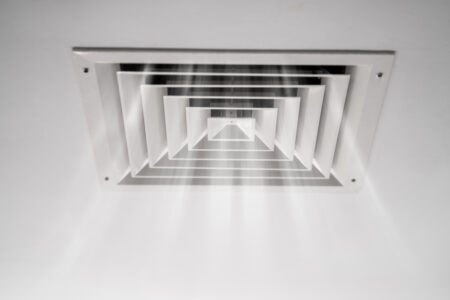
What is Ventilation and Why Does It Matter?
Ventilation is the movement of air in and out of spaces.
Good ventilation can help remove things from the air that we don’t want to breathe in, such as chemicals and dust – and small virus particles released by someone who is infected with a respiratory virus, like SARS-CoV-2.
“The fewer virus particles in the air, the less likely you are to breathe them in, or that the virus particles will land on your eyes or a surface that you might touch,” said Dr. Abigail Carlson, an infectious diseases physician with the Centers for Disease Control & Prevention (CDC), as part of CDC Project Firstline’s Inside Infection Control video series.
The Importance of Air Changes
Good ventilation involves air changes, which means that the air in a room is replaced with new or filtered air.
Air changes are usually measured by the hour – i.e., air changes per hour (ACH). In healthcare facilities, nearly every type of room has a recommended number of ACH to prevent germs from spreading to patients and healthcare workers. For example, 12 ACHs are recommended for emergency department waiting rooms.
The ACH will tell you how long the room should sit empty after a person who has (or might have) a respiratory virus leaves the room, and before another person can come in without a respirator or other PPE.
It is OK to enter a room before the air is completely cleared, including when a patient with a respiratory virus such as COVID-19 is still there, as long as you use the recommended PPE, which for COVID-19 includes a fit-tested respirator.
“Even before COVID-19, these recommendations were in place for air exchanges because it’s that important to make sure that air is reasonably clean and moves in and out of rooms,” said Dr. Carlson.
Checking Ventilation
“Ventilation is important. And it’s one of the many tools that we have to keep infections like COVID 19 from spreading,” said Dr. Carlson. One way to check if there’s ventilation in a room is to look for vents and fans. 
If a room does not have a ventilation system that moves the air, tools like high-efficiency particulate air (HEPA) filters may be used to clean the air by filtering it, instead of removing it.
There are some simple ways to increase the ventilation in a room, like opening a window. But because rooms are often connected in healthcare facilities, doing some of these things can change the air pressure and ventilation in other places too.
Always check with your building’s engineering or maintenance staff, or the people in your facility who oversee air handling and ventilation, before making changes to the ventilation in a room.
What Can You Do to Promote Infection Control in Your Healthcare Setting?
Access more information about infection prevention and control in healthcare by visiting resources from CDC Project Firstline.
Project Firstline creates resources, including videos and shareable images, web buttons, posters, and print materials. They also have facilitator toolkits to help workers lead trainings even if they are not an infection control expert.
Salud America! at UT Health San Antonio is working with the National Hispanic Medical Association to bring Project Firstline infection control educational content to healthcare workers, so they are equipped with the knowledge they need to protect themselves, their facilities, and their patients (Latinos and all communities) from infectious disease threats in healthcare settings.
You can read these articles:
- What is Project Firstline?
- What’s a Virus?
- How Does Infection Control Work on COVID-19 Variants Like Omicron?
- Contact Time: What is It and How Does it Impact Infection Control?
- The Surprising Difference Between Cleaning and Disinfection
- What’s a Respiratory Droplet and Why Does It Matter?
- Why Do Cleaning and Disinfection Matter in Healthcare?
- We Need to Talk about Hand Hygiene Again
- What is the Goal of Infection Prevention and Control in Healthcare Settings?
- The Intersection of Infection Prevention and Control and Healthcare Equity
- N95 Respirators: Everything You Need to Know
- How Do I Safely Use a Multi-Dose Vaccine Vial?
“Healthcare teams in hospitals, nursing homes, and other care settings are the front lines against the spread of infection,” said Dr. Amelie G. Ramirez, director of Salud America! at UT Health San Antonio. “CDC’s Project Firstline is bolstering those efforts by developing evidence-based tools that can be delivered in a variety of ways to make infection control learning convenient and accessible for busy healthcare staff.”
LEARN MORE ABOUT PROJECT FIRSTLINE!
Editor’s Note: This article is part of a collaboration between Salud America!, the National Hispanic Medical Association, and the CDC’s Project Firstline. To find resources training materials, and other tools to bolster knowledge and practice of infection control, visit Project Firstline and view Salud America!’s infection control content .
The post What is Ventilation and Why Does It Matter? appeared first on Salud America.

